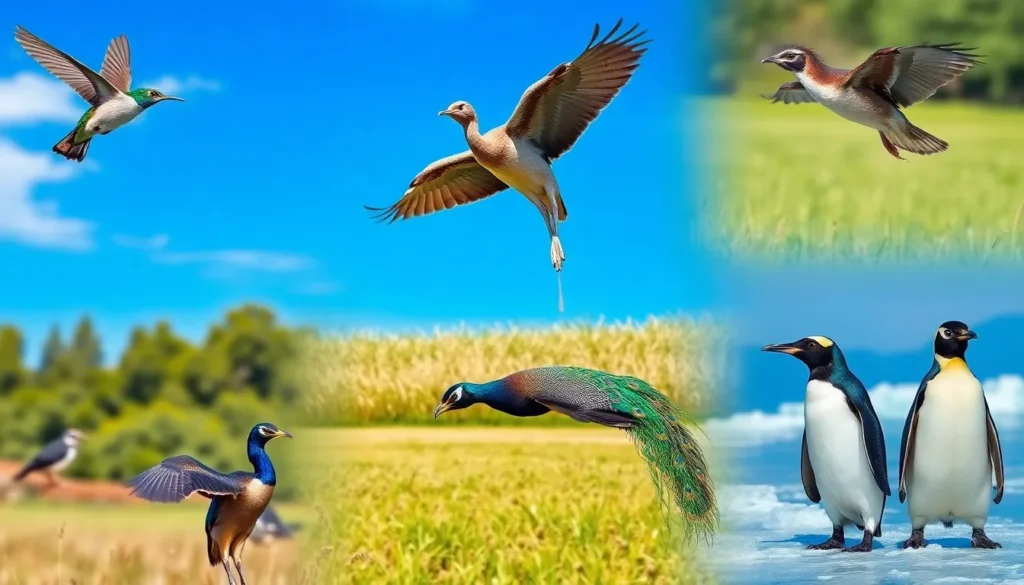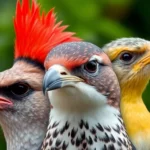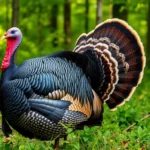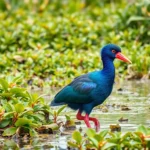Birds captivate us with their incredible diversity and remarkable abilities that seem almost magical. From the tiny hummingbird that can fly backwards to the massive ostrich that can outrun most cars, these feathered creatures continue to amaze scientists and nature enthusiasts alike.
We’ve all watched birds soar through the sky and wondered about their secret lives. What we’re about to discover will change how you see every robin in your backyard and every eagle circling overhead. These aren’t just the basic facts you learned in school – we’re talking about mind-blowing abilities that’ll make you question everything you thought you knew about our feathered friends.
Whether you’re a seasoned birdwatcher or someone who’s never given birds a second thought, these fascinating facts will open your eyes to the extraordinary industry that’s been flying right above us all along. Get ready to be amazed by nature’s most versatile creatures.
Amazing Physical Characteristics of Birds
Birds possess extraordinary physical features that enable their diverse lifestyles and remarkable survival abilities. These anatomical marvels represent millions of years of evolutionary refinement that continues to fascinate researchers worldwide.
Unique Feather Structures and Functions
Feathers serve multiple critical functions beyond flight, including temperature regulation, waterproofing, and communication displays. Contour feathers create the bird’s external shape and provide aerodynamic properties, while down feathers trap air for insulation. Flight feathers contain specialized barbules with tiny hooks called barbicels that zip together, creating a continuous surface for lift generation.
Penguin feathers demonstrate exceptional adaptation with three distinct layers: outer contour feathers, middle plumules, and inner down feathers that trap warm air. Peacock feathers contain microscopic structures called barbules that reflect light at exact wavelengths, producing iridescent colors without pigments. Owl feathers feature soft fringes on their edges that eliminate sound during flight, making them silent hunters.
Extraordinary Vision and Hearing Abilities
Bird vision surpasses human capabilities in multiple aspects, with many species detecting ultraviolet light invisible to our eyes. Raptors like eagles possess visual acuity 8 times sharper than humans, allowing them to spot prey from distances exceeding 2 miles. Their eyes contain specialized oil droplets that filter light and enhance color discrimination.
Nocturnal birds demonstrate remarkable hearing adaptations, with barn owls locating prey through sound alone in complete darkness. Their facial disc feathers funnel sound waves to asymmetrically positioned ears, creating precise directional hearing. Some birds detect infrasound frequencies below 20 Hz, enabling them to sense approaching storms or distant geographical features.
| Vision Capability | Human | Eagle | Owl |
|---|---|---|---|
| Visual Acuity | 20/20 | 20/2.5 | 20/100 |
| Light Detection Range | 400-700 nm | 300-700 nm | 300-1000 nm |
| Eyes per Body Weight | 1% | 4.6% | 5% |
Remarkable Bone Structure Adaptations
Bird bones exhibit hollow construction filled with air spaces called pneumatic bones, reducing weight while maintaining structural strength. These air-filled bones connect to the respiratory system, creating an efficient breathing mechanism during flight. Flight birds possess fused vertebrae and specialized shoulder structures that provide stable attachment points for powerful flight muscles.
Diving birds demonstrate dense bone adaptations that eliminate buoyancy, allowing underwater pursuit of prey. Penguin bones lack air spaces and contain increased mineral density, making them 3 times heavier than typical bird bones. Flightless birds like ostriches develop robust leg bones capable of supporting their substantial body weight and generating running speeds up to 45 mph.
Wishbones, formed by fused clavicles, act as springs during flight by flexing with each wingbeat and storing energy for the next stroke. Keel bones provide attachment surfaces for flight muscles that can comprise up to 35% of a bird’s total body weight in strong fliers like hummingbirds.
Incredible Flight Capabilities and Migration Patterns
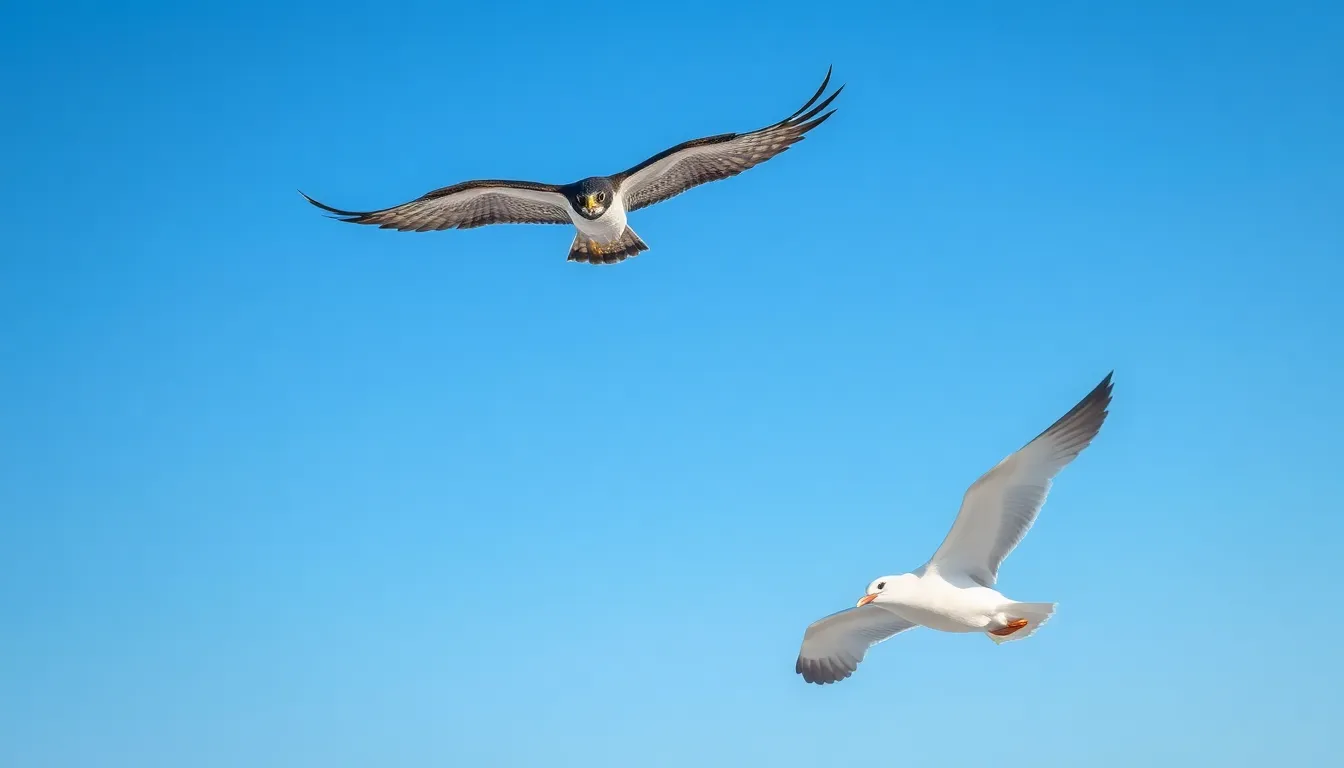
Bird flight represents one of nature’s most sophisticated achievements, combining aerodynamic mastery with navigational precision. These aerial athletes demonstrate capabilities that surpass human engineering in both efficiency and endurance.
Record-Breaking Speed and Distance Champions
Peregrine falcons hold the title for fastest bird species, reaching diving speeds of 242 mph during hunting stoops. Arctic terns complete the longest migration journey, traveling roughly 44,000 miles annually from Arctic breeding grounds to Antarctic feeding areas. Wandering albatrosses showcase exceptional gliding efficiency, covering up to 500 miles per day while barely flapping their 11-foot wingspan.
Golden eagles demonstrate remarkable thermal soaring, ascending to altitudes exceeding 20,000 feet using rising air currents. Bar-tailed godwits accomplish non-stop flights spanning 7,000 miles across the Pacific Ocean without landing or feeding. Ruby-throated hummingbirds cross the Gulf of Mexico in a single 500-mile flight even though weighing only 3 grams.
| Species | Speed/Distance Record | Notable Achievement |
|---|---|---|
| Peregrine Falcon | 242 mph diving speed | Fastest recorded bird |
| Arctic Tern | 44,000 miles annually | Longest migration route |
| Bar-tailed Godwit | 7,000 miles non-stop | Longest continuous flight |
| Wandering Albatross | 500 miles daily | Most efficient glider |
Navigation Mysteries and Magnetic Sensing
Birds possess magnetoreception abilities through specialized cells containing magnetite crystals in their beaks and eyes. European robins detect Earth’s magnetic field using cryptochrome proteins in their retinas, creating a visual magnetic compass overlay. Homing pigeons combine multiple navigation systems including magnetic sensing, sun compass orientation, and landmark recognition.
Migratory songbirds calibrate their magnetic compass using stellar patterns during their first autumn migration. Sea turtles and salmon use similar magnetic navigation, but birds demonstrate superior precision in returning to exact breeding territories within meters of previous year locations. Research indicates that radio frequency interference disrupts bird navigation, confirming their reliance on electromagnetic field detection.
Altitude Masters and Weather Adaptations
Bar-headed geese migrate over Mount Everest at altitudes reaching 29,000 feet, utilizing specialized hemoglobin that captures oxygen more efficiently than lowland species. Rüppell’s vultures soar at confirmed altitudes of 37,000 feet, requiring unique respiratory adaptations to function in thin atmosphere conditions.
Emperor penguins endure Antarctic temperatures of minus 40°F while incubating eggs for 64 consecutive days. Snowy owls hunt effectively during Arctic blizzards using asymmetrical ear placement that pinpoints prey location beneath snow cover. Ptarmigans grow feathered feet during winter months, creating natural snowshoes that distribute weight across soft snow surfaces.
These high-altitude specialists possess enlarged hearts and enhanced oxygen-carrying capacity compared to their low-altitude relatives. Storm petrels ride hurricane winds for extended periods, using turbulent air currents to maintain flight with minimal energy expenditure.
Fascinating Bird Intelligence and Social Behaviors
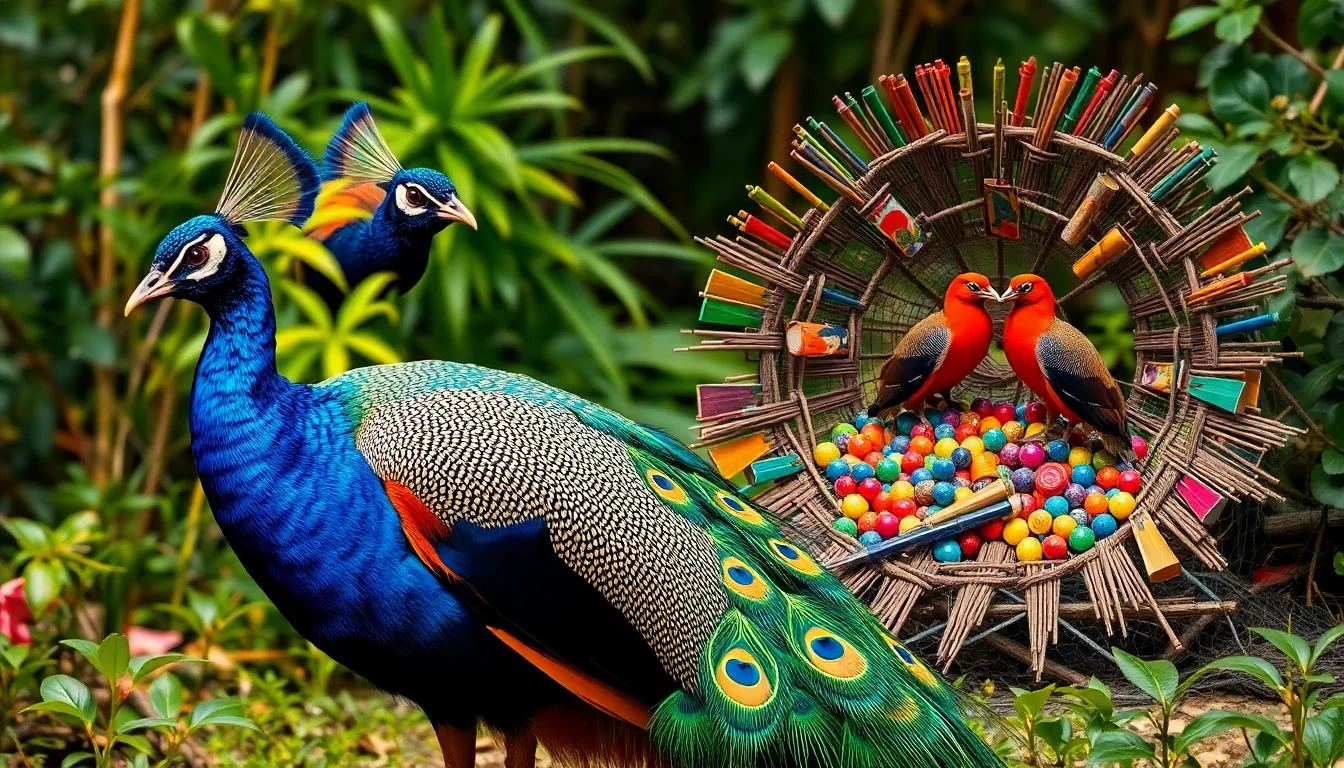
Bird intelligence demonstrates capabilities that rival many mammals in complexity and sophistication. These cognitive abilities showcase problem solving skills that adapt to environmental challenges and social interactions requiring advanced communication systems.
Problem-Solving Skills and Tool Usage
Corvids like crows and ravens manipulate objects to extract food from narrow spaces with remarkable precision. New Caledonian crows create hooks from twigs and leaves to probe insects from tree bark crevices. Woodpecker finches on the Galápagos Islands select cactus spines and twigs to extract grubs from holes they can’t reach with their beaks alone.
African grey parrots demonstrate logical reasoning by solving multi step puzzles that require sequential actions. Betty the crow gained scientific recognition by spontaneously bending wire into a hook to retrieve food from a vertical tube without prior training. Ravens in laboratory settings show planning abilities by selecting tools they’ll need for future tasks up to 17 hours in advance.
Kea parrots from New Zealand use stones to break open nuts and manipulate complex mechanical devices for food rewards. Urban ravens adapt their problem solving techniques to city environments by using traffic to crack nuts and timing their collection with traffic light patterns.
Complex Communication and Language Abilities
Songbirds develop regional dialects that vary between populations separated by geographic barriers. White crowned sparrows learn distinct song patterns during critical periods in their development, creating cultural transmission across generations. African grey parrots like Alex demonstrated vocabulary recognition of over 100 words with contextual understanding of concepts including colors, shapes, and numbers.
Mockingbirds incorporate sounds from their environment into complex song repertoires that can include over 200 different phrases. Ravens use at least 30 distinct vocalizations for different social contexts including alarm calls, territorial warnings, and food location announcements. Hummingbirds produce vocal learning patterns similar to human speech acquisition, adjusting their calls based on social feedback.
Chickadee alarm calls encode exact information about predator types, with different call structures indicating whether threats come from aerial predators like hawks or ground predators like cats. European starlings combine whistles, clicks, and warbles in sequences that follow grammatical rules, suggesting proto language capabilities.
Intricate Mating Rituals and Courtship Displays
Male peacocks spread iridescent tail feathers displaying up to 200 eye spots while producing low frequency sounds that vibrate through the ground to attract females from distances exceeding 1 mile. Bowerbirds construct elaborate structures decorated with colorful objects like blue bottle caps, berries, and shells arranged in precise patterns that demonstrate aesthetic preferences.
Red capped manakins perform coordinated dance routines where males work together in partnerships, with subordinate males helping dominant partners attract females through synchronized movements. Blue footed boobies engage in sky pointing displays where pairs mirror each other’s postures while showing off their bright blue feet as indicators of health and genetic quality.
Sandhill cranes perform elaborate dancing ceremonies involving leaping, wing spreading, and synchronized calling that strengthens pair bonds lasting multiple breeding seasons. Male frigatebirds inflate bright red throat pouches to basketball size while making drumming sounds and wing movements that can continue for hours during breeding displays.
Albatross pairs develop unique greeting ceremonies with exact bill touching patterns and synchronized head movements that serve as recognition signals between long term mates. These courtship behaviors demonstrate cognitive complexity in mate selection and relationship maintenance across species.
Diverse Feeding Habits and Survival Strategies

Bird species display remarkable ingenuity in securing food resources and adapting to environmental challenges. These feeding strategies showcase evolutionary brilliance that’s enabled birds to colonize virtually every habitat on Earth.
Specialized Hunting Techniques
Peregrine falcons execute precision dives at 242 mph to strike prey with devastating accuracy. These aerial predators use their incredible speed to create fatal impact forces that instantly disable their targets. Great blue herons employ patient stillness in shallow waters before striking with lightning-fast precision.
Woodpeckers use specialized skull adaptations and reinforced beaks to excavate insects from tree bark with surgical accuracy. Their tongues extend up to 4 inches beyond their beaks to extract prey from deep crevices. Kingfishers calculate light refraction angles when diving for fish underwater, compensating for visual distortion with remarkable precision.
Secretary birds stomp venomous snakes to death using powerful leg strikes that deliver 5 times their body weight in force. These ground hunters can dispatch cobra species that pose lethal threats to most other animals. Owls employ asymmetrically placed ears to triangulate mouse movements in complete darkness with pinpoint accuracy.
Unique Dietary Adaptations
Hummingbirds consume up to 8 times their body weight daily in nectar to fuel their high-speed metabolism. Their specialized tongues feature grooves that create capillary action for efficient nectar extraction from flowers. Pelican pouches can hold 3 gallons of water and fish, functioning as expandable fishing nets during feeding.
Flamingos filter microscopic algae and brine shrimp through specialized lamellae structures in their curved beaks. These filtering systems process thousands of gallons of water daily to extract sufficient nutrition. Crossbills possess uniquely twisted mandibles that perfectly align with exact conifer cone structures for seed extraction.
Bearded vultures digest bone marrow by dropping large bones from heights exceeding 260 feet onto rocky surfaces. Their stomach acid maintains pH levels around 1.0, enabling them to dissolve bone fragments that other scavengers cannot process. Honeyguides consume beeswax through specialized digestive bacteria that break down this otherwise indigestible substance.
Food Storage and Caching Behaviors
Clark’s nutcrackers memorize locations of up to 33,000 seed caches across mountainous terrain with spatial accuracy. These corvids bury pine seeds in autumn and retrieve them throughout winter with 90% success rates. Acorn woodpeckers create granaries containing up to 50,000 acorns stored in individually drilled holes.
Shrikes impale prey on thorns and barbed wire to create natural refrigeration systems for future consumption. These “butcher birds” maintain multiple food storage sites across their territories, returning to cached meals when hunting proves unsuccessful. Arctic foxes aren’t the only species that cache food strategically – gray jays store thousands of food items using specialized saliva that preserves perishables in freezing temperatures.
Marsh tits remember exact locations of hundreds of seed hiding spots for up to 30 days. Their hippocampus regions enlarge during caching seasons to accommodate increased spatial memory demands. European jays transport up to 5,000 acorns annually over distances exceeding 3 miles to establish winter food reserves.
Surprising Nesting and Parenting Facts
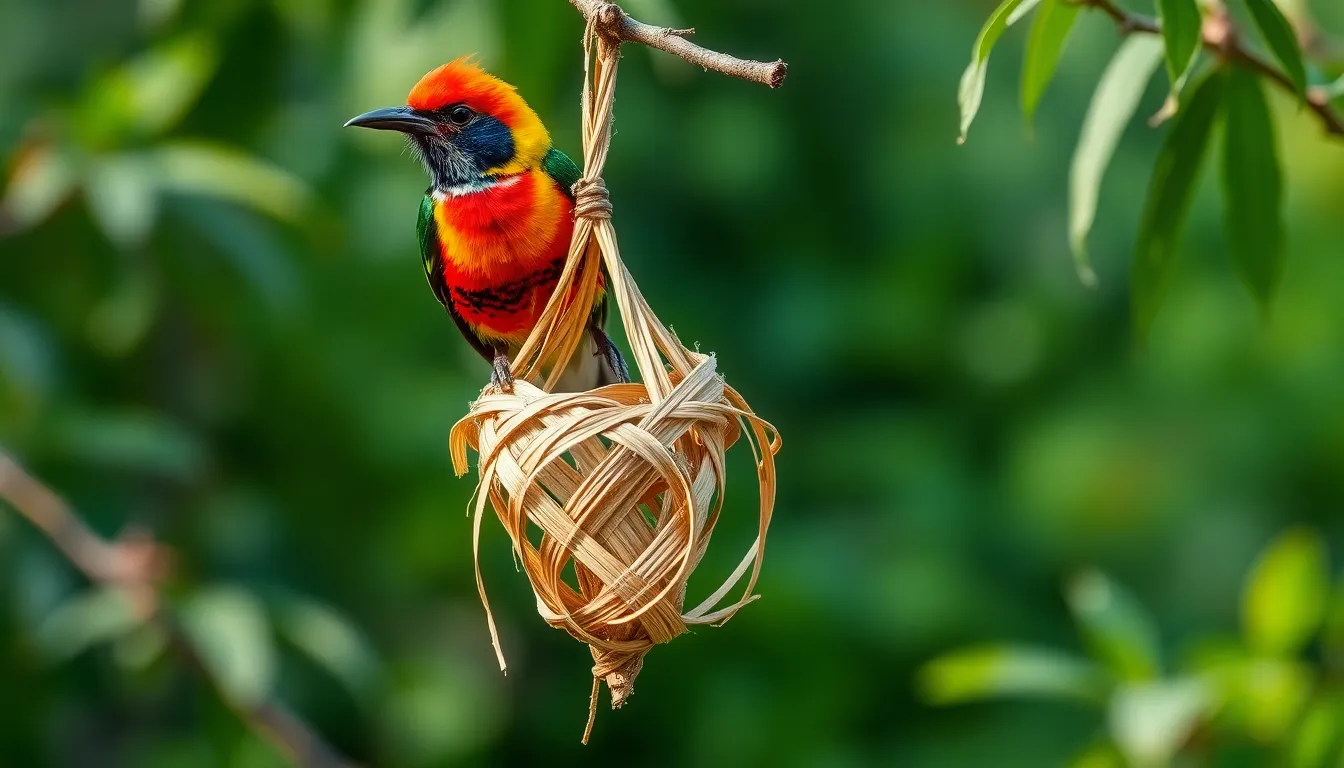
Bird families showcase extraordinary parenting strategies and construction abilities that rival human engineering. These remarkable behaviors demonstrate the complex social structures and innovative problem-solving skills that extend far beyond basic survival instincts.
Architectural Marvels in Bird Construction
Weaver birds create intricate hanging nests that incorporate over 1,000 individual grass strips woven together with mathematical precision. Male village weavers spend 9-14 days constructing these spherical masterpieces, which feature entrance tunnels that spiral downward to prevent snake infiltration. The sociable weaver of southern Africa builds massive communal structures spanning 20 feet wide and 10 feet tall, housing up to 400 breeding pairs across multiple generations.
Bower birds construct elaborate courtship arenas decorated with exact color arrangements, often favoring blue objects like bottle caps, feathers, and flowers. Satin bowerbirds collect an average of 3,000-4,000 decorative items, organizing them by color intensity to create optical illusions that enhance their display effectiveness. These architectural achievements require spatial memory capabilities that researchers compare to human artistic expression.
Hornbills employ unique construction techniques by sealing females inside tree cavities using mud, fruit pulp, and saliva. The male provisions the sealed female and chicks through a small opening for 2-4 months, delivering food every 20-30 minutes during daylight hours. This remarkable building strategy protects offspring from predators while creating complete dependency between breeding pairs.
Cooperative Breeding and Community Care
Florida scrub jays demonstrate complex cooperative breeding systems where offspring remain with parents for 2-6 years as helpers. These helper birds assist in territory defense, predator detection, and feeding duties, increasing chick survival rates by 35-50% compared to pairs without helpers. Breeding territories require 22-25 acres of suitable scrub habitat per family group.
Acorn woodpeckers operate sophisticated communal storage systems called granaries, where extended family groups collaborate to drill 50,000+ holes in dead trees for acorn storage. Family units consist of 2-7 breeding males, 1-3 breeding females, and multiple helper birds that collectively maintain territory boundaries spanning 15-20 acres. Community members share parenting responsibilities equally, with helpers contributing 40-60% of total chick feeding efforts.
Australian superb fairy wrens form breeding cooperatives where dominant males mate with multiple females while subordinate males assist in chick rearing without reproductive benefits. Groups typically include 1 breeding pair and 2-5 helper males, with helpers providing 25-30% of total food deliveries to nestlings during the 14-day fledgling period.
Egg Incubation Strategies
Emperor penguins execute remarkable incubation techniques in Antarctica’s harsh conditions, with males balancing eggs on their feet under specialized brood pouches for 64-67 days. Males lose 30-45% of their body weight during incubation periods while enduring temperatures reaching -40°F and winds exceeding 90 mph. Females travel 60-75 miles to feeding grounds, returning precisely when chicks hatch.
Megapode birds employ geothermal incubation methods by burying eggs in volcanic soil or constructing massive compost mounds reaching 15 feet in height and 35 feet in diameter. Male malleefowl regulate mound temperatures within 1-2°F by adding or removing organic material, maintaining consistent 91°F conditions for the entire 62-day incubation period. Chicks emerge fully developed and immediately capable of flight.
Hornbill species demonstrate exceptional incubation coordination where males deliver food to sealed females every 6-10 minutes throughout daylight hours. Great hornbills maintain feeding schedules for 105-120 days, providing over 24,000 food items including fruits, insects, and small vertebrates during the complete nesting cycle. Females molt all flight feathers during confinement, becoming completely dependent on male provisioning until chick fledging occurs.
Record-Breaking Birds Around the World

Bird facts showcase remarkable extremes that challenge our understanding of physical limitations. These extraordinary achievements span size variations, longevity records, and speed performances that demonstrate evolutionary brilliance.
Size Extremes: Largest and Smallest Species
Common ostriches claim the title of largest living birds, reaching heights of 9 feet and weighing up to 320 pounds. These African giants possess powerful legs that generate running speeds of 43 mph across savanna landscapes. Male ostriches display distinctive black and white plumage during breeding seasons, while females maintain protective brown coloring.
Bee hummingbirds from Cuba represent the smallest bird species on Earth, measuring just 2 inches in length and weighing 0.07 ounces. These tiny marvels beat their wings 80 times per second, creating the characteristic humming sound that gives them their name. Females build nests the size of half walnut shells using spider webs and plant fibers.
Wandering albatrosses boast the largest wingspan among living birds, stretching up to 11.5 feet from tip to tip. These ocean masters use ever-changing soaring techniques to glide thousands of miles without flapping, riding wind currents above Southern Ocean waves. Their aerodynamic efficiency allows them to travel 500 miles per day during foraging flights.
Longevity Champions and Lifespan Variations
Wisdom the Laysan albatross holds documented records as the oldest known wild bird, reaching at least 72 years old. Scientists have tracked her breeding activities on Midway Atoll since 1956, where she continues producing chicks well into her seventh decade. Her remarkable longevity demonstrates seabird resilience and successful conservation efforts.
Large parrot species regularly achieve lifespans exceeding 50 years in both wild and captive environments. Cockatoos, macaws, and African grey parrots often outlive their human caretakers, with some specimens documented at over 100 years old. Their extended lifespans correlate with high intelligence levels and complex social structures.
Arctic terns experience dual advantages of longevity and extraordinary migration distances throughout their 30-year lifespans. These remarkable birds complete annual journeys of 44,000 miles between Arctic and Antarctic regions, accumulating lifetime travel distances equivalent to three round trips to the moon. Their longevity combined with migration patterns results in more daylight exposure than any other creature on Earth.
Speed Records on Land, Air, and Water
Peregrine falcons achieve the fastest speeds recorded by any animal during hunting dives, reaching 242 mph when stooping toward prey. Their specialized nostrils contain baffles that prevent lung damage from high-speed air pressure, while transparent eyelids protect their vision during rapid descents. Urban populations have adapted to hunt pigeons among skyscrapers, demonstrating remarkable behavioral flexibility.
Golden eagles dominate horizontal flight speed records among raptors, maintaining sustained speeds of 80 mph during territorial patrols. These powerful hunters combine speed with precision targeting, enabling successful captures of prey ranging from rabbits to young deer. Their flight efficiency allows coverage of territories spanning 60 square miles.
Gentoo penguins claim underwater speed championships, propelling themselves through Antarctic waters at 22 mph using powerful wing strokes. Their streamlined bodies and dense bone structure provide optimal hydrodynamics for pursuing krill and fish beneath ice shelves. These aquatic athletes can dive to depths of 655 feet while maintaining impressive swimming speeds.
Conclusion
We’ve journeyed through an extraordinary industry where feathered creatures continue to amaze us with their remarkable abilities. From magnetic navigation systems to tool-wielding intelligence these avian marvels showcase nature’s incredible ingenuity at every turn.
The next time we spot a bird outside our window we’ll see more than just another animal. We’ll recognize a masterpiece of evolution equipped with hollow bones ultraviolet vision and complex social behaviors that rival our own societies.
These fascinating facts remind us that birds aren’t just background characters in our daily lives—they’re sophisticated beings whose stories deserve our attention and respect. Their industry is far more intricate and captivating than we ever imagined.
Frequently Asked Questions
What makes bird feathers so special and unique?
Bird feathers have remarkable structures that serve multiple functions including flight, temperature regulation, and communication. They provide excellent insulation like in penguins, create stunning color displays as seen in peacocks, and enable the aerodynamic properties necessary for flight. Each feather type is specifically adapted to help birds survive in their particular environments.
How do birds’ vision and hearing abilities compare to humans?
Birds possess extraordinary sensory capabilities that far exceed human abilities. Many species can detect ultraviolet light, allowing them to see patterns invisible to us. Their hearing is equally impressive, with some birds having acute auditory adaptations that enable them to locate prey in complete darkness through sound alone.
Why do birds have hollow bones and how does this help them?
Birds have hollow pneumatic bones that significantly reduce their body weight while maintaining structural strength, making flight possible. These specialized bone adaptations vary by species – diving birds have denser bones for underwater activities, while flightless birds like ostriches have robust leg bones to support their terrestrial lifestyle.
Which birds hold the most impressive flight and migration records?
The peregrine falcon holds the speed record at 242 mph during hunting dives, while the Arctic tern completes an incredible 44,000-mile annual migration. The bar-tailed godwit demonstrates remarkable endurance in long-distance flights, and the wandering albatross showcases exceptional efficiency in flight patterns across vast ocean distances.
How intelligent are birds and what problem-solving abilities do they have?
Birds display remarkable intelligence and problem-solving skills. Corvids (crows and ravens) are known for using tools and demonstrating advanced cognitive abilities. African grey parrots exhibit complex communication systems and language capabilities. Many species also show sophisticated social behaviors and intricate mating rituals that require significant cognitive processing.
What are the most unique feeding strategies used by birds?
Birds have developed incredible feeding adaptations and hunting techniques. Peregrine falcons use precision diving attacks, while great blue herons employ patient striking methods. Hummingbirds consume massive amounts of nectar relative to their size, and flamingos use specialized filtering systems to extract algae from water.
How do birds navigate during long migrations?
Birds use magnetoreception to detect Earth’s magnetic field, enabling precise navigation over thousands of miles. This natural GPS system, combined with other environmental cues like star patterns and landmarks, allows species like the Arctic tern to complete their remarkable annual migrations with incredible accuracy.
What are some of the most impressive nesting behaviors in birds?
Birds display extraordinary nest construction and parenting strategies. Weaver birds create intricate hanging nests, while bower birds build elaborate courtship arenas. Emperor penguins have unique egg incubation methods in extreme cold, and some species like Florida scrub jays practice cooperative breeding where multiple adults help raise offspring.
Which birds hold the most extreme size and longevity records?
The common ostrich is the largest living bird, while the bee hummingbird is the smallest. The wandering albatross has the most impressive wingspan. For longevity, Wisdom the Laysan albatross is famous for her remarkable age. Gentoo penguins hold underwater speed records, demonstrating the incredible diversity of bird achievements.

